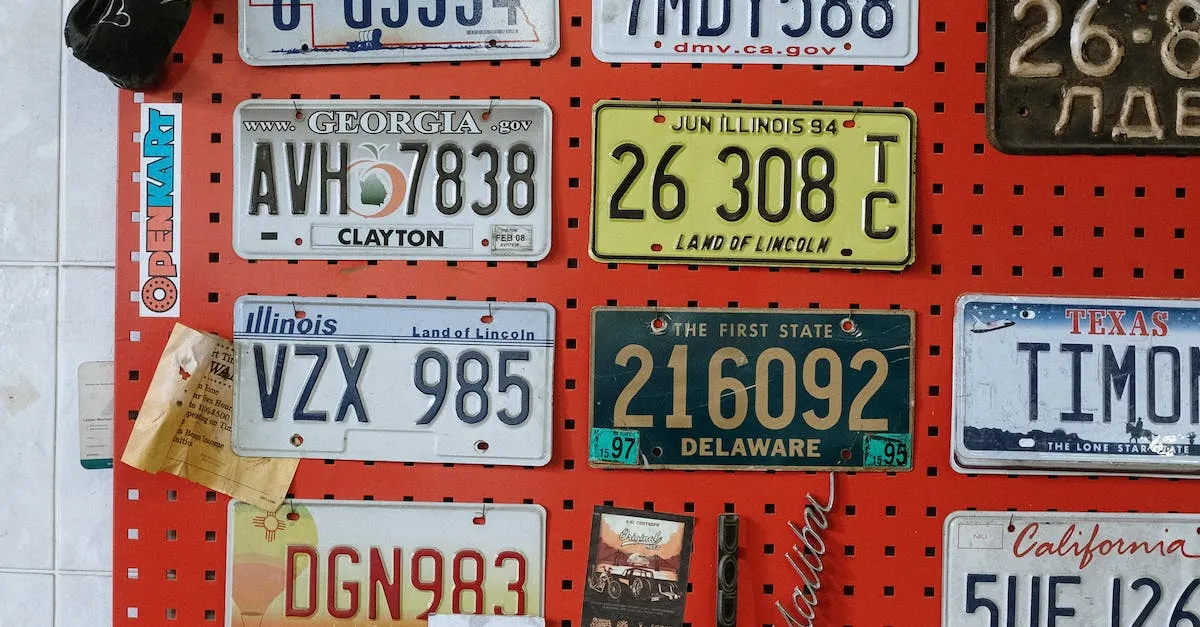How To Get License Plates In Texas: A Step-By-Step Guide
Getting new license plates for your car in Texas involves following some important steps and meeting certain requirements. Whether you’re titling a new vehicle or replacing old plates, this process can seem complicated.
If you’re short on time, here’s a quick overview of how to get license plates in Texas: You’ll need to title and register your vehicle with your county tax office, provide required documentation, pay applicable fees, and then you’ll receive your plates in the mail.
This comprehensive guide will walk through all the steps and requirements for obtaining your license plates from the TX DMV. We’ll cover everything from title transfers and registration to specialty plates and plate replacement.
Texas Vehicle Title and Registration
Obtaining the proper vehicle title and registration is an important step when getting license plates in Texas. This process ensures that your vehicle is legally recognized and allows you to drive on the state’s roads.
Here is a step-by-step guide to help you navigate through the Texas vehicle title and registration process.
Obtaining Your Vehicle Title
The first step in getting license plates for your vehicle in Texas is to obtain the vehicle title. This document serves as proof of ownership and is required when registering your vehicle. To obtain the vehicle title, you will need to:
- Fill out the Application for Texas Certificate of Title (Form 130-U).
- Provide proof of identification, such as a driver’s license or passport.
- Submit documentation that proves ownership, such as a bill of sale or manufacturer’s certificate of origin.
- Pay the required fees.
Once you have completed these steps, you will receive the vehicle title. It is important to keep this document safe, as you will need it for future registration and transfer of ownership.
Initial Vehicle Registration
After obtaining the vehicle title, the next step is to register your vehicle in Texas. This is necessary to obtain license plates and legally operate your vehicle. To register your vehicle, follow these steps:
- Complete the Application for Texas Certificate of Title (Form 130-U).
- Provide proof of identification and residency.
- Present the vehicle title.
- Provide proof of insurance.
- Pay the required fees, including registration fees and any applicable taxes.
Once you have completed the registration process, you will receive your license plates. These plates must be affixed to your vehicle as required by Texas law.
Registration Renewal
Once your vehicle is registered and you have obtained license plates, it is important to keep your registration up to date. In Texas, vehicle registrations must be renewed annually. To renew your registration, follow these steps:
- Receive a renewal notice from the Texas Department of Motor Vehicles.
- Complete the renewal notice and provide any necessary updates.
- Pay the renewal fees.
- Receive your updated registration sticker to affix to your license plates.
It is important to renew your vehicle registration on time to avoid penalties or fines. Failure to renew your registration could result in the suspension of your driving privileges.
For more information on the Texas vehicle title and registration process, visit the official website of the Texas Department of Motor Vehicles at www.txdmv.gov.
Required Documentation
When getting license plates in Texas, there are several documents you will need to provide. These documents are necessary to ensure that you meet all legal requirements and can legally operate your vehicle on the road.
Proof of Identification
One of the first documents you will need to provide when getting license plates in Texas is proof of identification. This can be in the form of a valid driver’s license or a state-issued identification card.
It’s important to have this document readily available as it verifies your identity and ensures that you are eligible to register a vehicle.
Vehicle Purchase Documentation
In order to register your vehicle and obtain license plates, you will need to provide documentation that proves you are the owner. This can include a bill of sale, a vehicle title, or a Manufacturer’s Certificate of Origin (MCO).
These documents provide proof that the vehicle is legally yours and can be registered in your name.
Insurance Information
Proof of insurance is another crucial document you will need when getting license plates in Texas. You must have a valid auto insurance policy that meets the state’s minimum coverage requirements. This includes liability coverage for bodily injury and property damage.
Be sure to bring a copy of your insurance card or policy declaration page as proof of coverage.
Vehicle Inspection
Before you can obtain license plates in Texas, your vehicle must pass a state inspection. This inspection ensures that your vehicle meets safety and emissions standards. You will need to provide proof of inspection by presenting a valid Vehicle Inspection Report (VIR) issued by a certified inspection station.
It’s important to remember that the specific documentation requirements may vary depending on your situation. It’s always a good idea to check the official website of the Texas Department of Motor Vehicles for the most up-to-date information on required documentation.
License Plate Fees
When it comes to getting license plates in Texas, it’s important to be aware of the various fees associated with the process. Understanding these fees will help you budget accordingly and ensure a smooth experience. Here are the key license plate fees you should know about:
Title and Registration Costs
Before you can obtain license plates in Texas, you must first register your vehicle and obtain a title. The cost of title and registration varies depending on factors such as the type of vehicle, its weight, and the county in which you reside.
It’s recommended to check the Texas Department of Motor Vehicles website for the most up-to-date fee schedule.
Typically, the title fee ranges from $28 to $33, while the registration fee can range from $50 to $150. These fees cover the administrative costs associated with processing your application, issuing the title, and registering your vehicle with the state.
Annual Registration Renewal Fees
Once you have obtained license plates in Texas, you will need to renew your vehicle’s registration annually. The renewal fee varies based on factors such as the type of vehicle and its weight. The average renewal fee for a passenger vehicle is around $50.
However, it’s important to note that this fee can change, so it’s always a good idea to check the Texas Department of Motor Vehicles website for the current fee schedule.
To renew your registration, you can do so online, by mail, or in person at your local county tax office. Be sure to renew your registration on time to avoid any late fees or penalties.
Replacement Plate Fees
If you need to replace your license plates in Texas due to loss, theft, or damage, there is a fee associated with obtaining new plates. The replacement fee for license plates is typically around $6.50 per plate, plus an additional $1.50 processing fee.
This fee covers the cost of producing and issuing new plates for your vehicle.
It’s important to note that these fees are subject to change, so it’s always a good idea to check the Texas Department of Motor Vehicles website for the most up-to-date fee information. By being aware of these license plate fees, you can ensure a smooth and hassle-free process when obtaining or renewing your plates in Texas.
Specialty License Plates
Texas offers a variety of specialty license plates that allow drivers to personalize their vehicles or show support for specific organizations or causes. These specialty plates are a great way to add a unique touch to your vehicle and showcase your interests.
In this section, we will explore some of the different types of specialty license plates available in Texas.
Custom Plates in Texas
Custom license plates in Texas allow you to create a personalized message or combination of letters and numbers on your license plate. This can be a fun way to express your creativity and make your vehicle stand out.
To get a custom license plate, you will need to apply through the Texas Department of Motor Vehicles website and pay an additional fee. Keep in mind that there are certain guidelines and restrictions when it comes to custom license plates, so be sure to review the requirements before submitting your application.
Military, Nonprofit, and Vanity Plates
Texas offers a variety of specialty license plates for individuals who want to show their support for the military, nonprofit organizations, or simply want a unique vanity plate. These specialty plates often feature specific designs or logos related to the chosen organization or cause.
Some examples include plates for veterans, Purple Heart recipients, and organizations like the American Heart Association. To obtain these specialty plates, you will need to meet certain eligibility criteria and pay any required fees.
These plates not only allow you to customize your vehicle but also serve as a way to raise awareness and show support for important causes.
College and University Plates
If you are a proud alumni or current student of a Texas college or university, you can show your school spirit with a specialty license plate. Texas offers a wide range of college and university plates, featuring the logos and colors of various educational institutions.
Whether you attended a large state university or a small private college, you can find a specialty plate to represent your alma mater. These plates not only allow you to display your pride but also contribute to scholarship funds for each respective institution.
So, not only will you be showcasing your school spirit, but you’ll also be making a positive impact on the education of future students.
Whether you’re looking to personalize your license plate, show support for a cause, or represent your college or university, Texas specialty license plates offer a wide range of options. Remember to review the requirements and guidelines for each type of specialty plate before applying.
So, go ahead and add a touch of personalization and uniqueness to your vehicle with a specialty license plate in Texas!
Replacing Your License Plates
Lost, Stolen or Damaged Plates
If your license plates are lost, stolen, or damaged, it is important to take action as soon as possible. Not only are license plates a legal requirement, but driving without them can result in fines or penalties.
In Texas, the process for replacing lost, stolen, or damaged plates is relatively straightforward.
To replace your license plates, you will need to visit your local Department of Motor Vehicles (DMV) office or use the online services provided by the Texas DMV. You will be required to fill out an application form and provide proof of identification, such as your driver’s license or state-issued ID card.
Additionally, you may need to provide information about your vehicle, such as the VIN number.
Once you have submitted the necessary documentation, you will be issued new license plates. It is important to note that there may be a fee associated with replacing your license plates, which can vary depending on the circumstances.
Transferring Plates to a New Vehicle
If you are purchasing a new vehicle and wish to transfer your existing license plates to the new vehicle, you can do so in Texas. This can be a convenient option, as it allows you to keep your personalized or specialty plates without having to go through the process of obtaining new ones.
To transfer your license plates to a new vehicle, you will need to visit your local DMV office and provide the necessary documentation. This typically includes proof of ownership for the new vehicle, such as the vehicle title or bill of sale, as well as proof of insurance.
Once the transfer is complete, you will receive new registration stickers for your license plates, indicating that they are now registered to your new vehicle. It is important to note that there may be a fee associated with transferring your license plates, which can vary depending on the circumstances.
Updating Plate Info
If you need to update the information on your license plates, such as your address or vehicle details, it is important to notify the Texas DMV. Keeping your license plate information up to date is not only a legal requirement but also ensures that you receive important correspondence, such as registration renewal notices, in a timely manner.
To update your license plate information, you can visit your local DMV office or use the online services provided by the Texas DMV. You will need to provide the necessary documentation, such as proof of address or vehicle ownership, and fill out an application form.
Remember, it is important to keep your license plate information accurate and up to date to avoid any potential issues or penalties. If you have recently moved or changed vehicles, make sure to update your license plate information as soon as possible.
Conclusion
Getting new license plates in Texas involves following some important steps, including titling your vehicle, registering it, paying fees, and providing the required documentation. Understanding the process ahead of time makes obtaining your plates smooth and straightforward.
With this guide, you now have a detailed overview of the entire process, from applying for your title and registration to options like specialty plates and replacements. Just follow the steps for your situation and you’ll be ready to hit the road with your new Texas plates!








